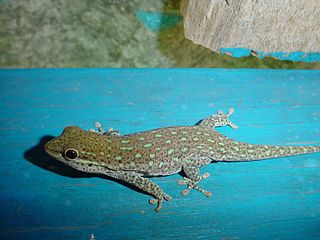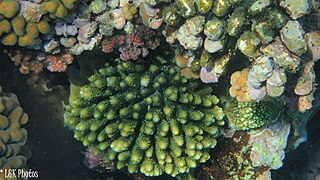
Phelsuma breviceps is a diurnal species of gecko that is native to south-west Madagascar and typically dwells on trees and bushes. Its diet in the wild consists mainly of insects.

Grandidier's mongoose, also known as the giant-striped mongoose or Grandidier's vontsira, is a small carnivoran that lives only in a very small area of southwestern Madagascar, in areas of spiny forest vegetation. It is pale brown or grayish coloured, with eight wide, dark stripes on its back and sides. Grandidier's mongoose is larger than the related broad-striped Malagasy mongoose, G. fasciata, and its stripes are not as wide. The species is named after Alfred Grandidier.

Lake Tsimanampetsotsa is a moderately alkaline lake in the Toliara Province, in the southwestern part of Madagascar. It is located at around 24°07′S43°45′E. The lake is protected within Tsimanampetsotsa National Park and it is also within a Ramsar site. The Ramsar site has a total area of 456 km2 (176 sq mi), while the surface of the lake is much smaller.

Ebenavia maintimainty is a small nocturnal gecko species of the genus Ebenavia that is native to Madagascar. It is found in a small area of limestone cliffs to the east of Lake Tsimanampetsotsa on the Mahafaly Plateau. This habitat forms part of the Madagascar spiny thickets ecoregion.

Moringa drouhardii, the bottle tree, is an endemic species of southwest Madagascar. It occurs in the Madagascar spiny thickets ecoregion, especially at the limestone cliffs to the east of Lake Tsimanampetsotsa, on the Mahafaly Plateau. The species is often planted in local villages and around traditional tombs. Neither the seeds nor the leaves are traditionally used in the Atsimo-Andrefana Region despite their significant benefits.
Articles related to Madagascar include:

The reddish-gray mouse lemur also known as the gray-brown mouse lemur or rufous-gray mouse lemur, is found in Western Madagascar in the region around Beza Mahafaly Reserve, north to Lamboharana.

The Madagascar plover, also known as the black-banded plover, is a small monogamous shorebird in the family Charadriidae, native to western Madagascar. It inhabits shores of lagoons, coastal grasslands, and breeds in salt marshes. These plovers mainly nest in open grassland and dry mudflats surrounding alkaline lakes. The species is classified as vulnerable by the IUCN because of its low breeding success, slow reproductive rate, and weak adaptation to increasing habitat loss, leading to declining population numbers.

Typhleotris madagascariensis is a species of fish in the family Milyeringidae that is endemic to Madagascar, where it is only known from underground waters in the southwestern portion of the island. This cavefish is blind and lacks pigmentation, and can reach a standard length of 8 cm (3.1 in).

Atsimo-Andrefana is a region of Madagascar. It borders Menabe in north, Amoron'i Mania and Haute Matsiatra in northeast, Ihorombe and Anosy in east and Androy in southeast. The capital is Toliara and the population was 1,799,088 in 2018. Atsimo Andrefana is geographically the largest of all Malagasy regions with an area of 66,236 km2 (25,574 sq mi).

Tsimanampetsotsa National Park also spelt Tsimanampetsotse, and known as Tsimanampetsotsa Nature Reserve is a 432 km2 national park on the south-west coast of Madagascar in the region Atsimo-Andrefana. The park is 90 kilometres (56 mi) south of Toliara and 950 kilometres (590 mi) south of the capital, Antananarivo. Route Nationales (RN) 10 to Faux Cap passes the park and the nearest airport is at Toliara. The national park contains and is named after Lake Tsimanampetsotsa.

Petter's big-footed mouse, is a Madagascan rodent in the genus Macrotarsomys. With a head and body length of 150 mm (5.9 in) and body mass of 105 g (3.7 oz), It is the largest species of its genus. The upperparts are brown, darkest in the middle of the back, and the underparts are white to yellowish. The animal has long whiskers, short forelimbs, and long hindfeet. The tail ends in a prominent tuft of long, light hairs. The skull is robust and the molars are low-crowned and cuspidate.
Efoetsy is a village in Betioky Sud District in southwest Madagascar. It is connected by road to Ankiririsa in the northwest and Toliara, which is about 58 kilometres to the northwest. It lies just west of the northwestern bank of the Lake Tsimanampetsotsa. Behazomby lies to the south of the village.
Antanandranto, also Ankilibory, is a small town in southwest Madagascar. It lies southwest of the Lake Tsimanampetsotsa. It lies north of the villages of Anja-Belitsaka and Vohombe.
Meranoplus cryptomys is a Malagasy species of ant in the genus Meranoplus.

Commerson's roundleaf bat, also known as Commerson's leaf-nosed bat, is a species of bat endemic to Madagascar. It is named after French naturalist Philibert Commerson (1727-1773). Bat populations of Africa or São Tomé and Príncipe formerly considered part of this species are now classified separately as M. gigas, M. thomensis or M. vattatus, while one from Madagascar was split off to become M. cryptovalorona. It was formerly placed in the genus Hipposideros, but moved to the resurrected Macronycteris in 2017 on the basis of molecular evidence.

Nosy Ve-Androka National Park is a Protected Marine Area located in the southwestern part of Madagascar, south of Tulear, and 40 km south of the tourist village of Anakao. It lies between latitudes 25 ° 29/25 ° 09 South and longitudes 44 ° 50/45 ° 06 East and covers an area of 92080 ha. It is composed of Core Areas totalling 28,820 ha and Buffer Zones totalling 63,260 ha. The park is made up of eight parcels in two clusters, with part found along the coast adjacent to Tsimanampetsotsa National Park. It includes sections of the rich coral reef system of South West Madagascar in the Mozambique Channel, recognized as the third largest reef system in the world. Diversity of habitats include fringing reefs, barrier reefs, coral reef beds, seagrass area, open sea, rocky coast and sandy beaches. The Nosy Ve-Androka National Park contains about 140 species of coral and 240 species of fish. There are also rare species such as Coelacanths, marine turtle species, Dugongs, Dolphins and Whales and sandy beaches that are used by nesting sea turtles.
Little work has been done on the lichens of Madagascar, so while over 500 species of lichens have been documented, more are expected. Madagascar can be divided into two major habitats that can be associated with lichen distribution. Wet tropical areas of siliceous bedrock make up approximately two-thirds of the country, and are where most of the lichens have been documented. Dry tropical areas of granitic and limestone bedrock make up the other one-third of the country with just over 20 species documented in these habitats. The following table lists the species known from the dry tropical habitats. The majority are corticolous species that grow on the bark of trees or shrubs. A few are saxicolous; species that grow on rocks. The full list of 500 lichens can be found at.













